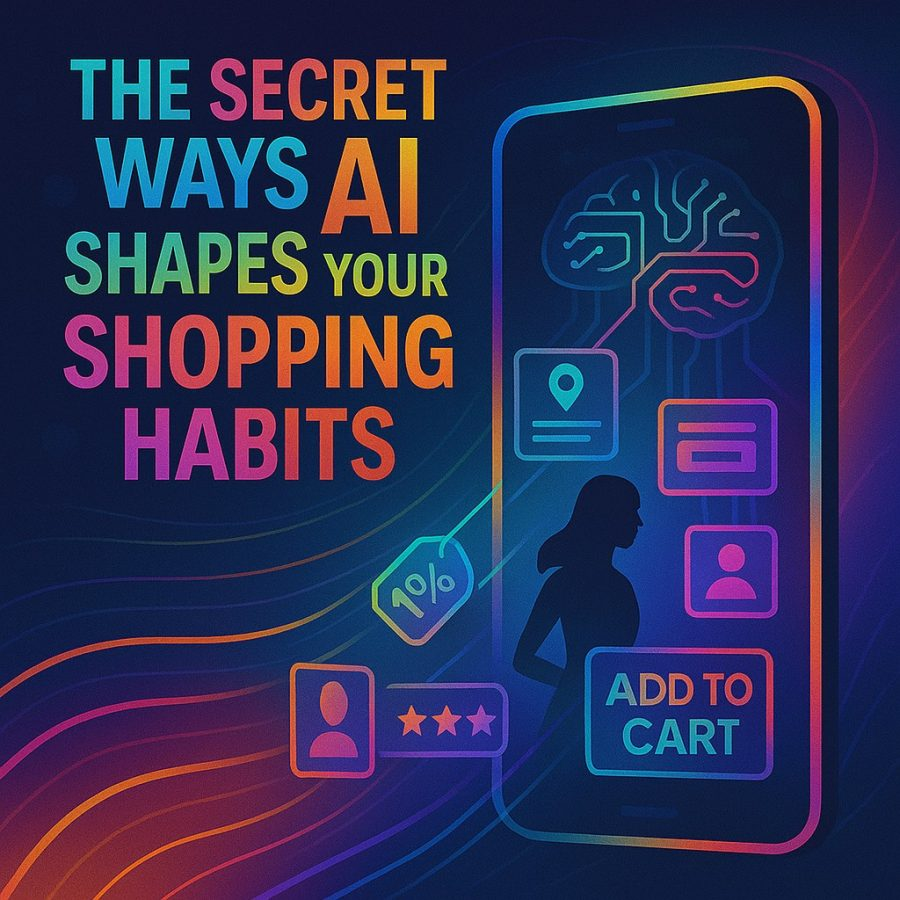Views: 3
Shopping today feels like magic. You think about a new pair of sneakers, and suddenly Instagram shows you three ads with sneakers in your favorite color. You browse an online store once, and the next week, you are convinced the universe wants you to buy that jacket. This is not coincidence. It is artificial intelligence at work. Welcome to The Secret Ways AI Shapes Your Shopping Habits, a deep dive into how algorithms guide your choices more than you realize.
At 5,000 words, this article will explore how AI personalizes your browsing, predicts your needs, sets prices, and even nudges you toward products you never planned to buy. The process is not random. It is systematic, precise, and constantly learning. From targeted ads to checkout tricks, AI has become the invisible salesperson who knows more about you than your favorite cashier ever could.

Why AI Loves Shoppers
Before breaking down tactics, let’s talk about why shopping is such fertile ground for artificial intelligence. Retail produces endless data: browsing histories, abandoned carts, purchase records, loyalty program activity, and even social media likes. AI thrives on patterns, and shoppers provide those patterns daily.
For companies, using AI means higher sales, fewer wasted ads, and improved customer loyalty. For shoppers, it often means convenience but sometimes also temptation. That tension defines The Secret Ways AI Shapes Your Shopping Habits—you benefit, but you also get steered.
Personalized Recommendations: The Digital Sales Assistant
Perhaps the most visible way AI influences your shopping is through personalized recommendations.
How It Works
AI uses collaborative filtering and deep learning to analyze what you and others like you have bought. If 10,000 people who bought running shoes also bought smartwatches, the system suggests a smartwatch after you add sneakers to your cart.
Where You See It
- Netflix-style “You might also like” lists on e-commerce sites.
- Amazon’s “Frequently bought together” bundles.
- Grocery apps suggesting recipes after you order pasta and sauce.
Why It Works
Humans are more likely to buy when they see items framed as relevant. Recommendations reduce decision fatigue while nudging you toward spending a little more.
Dynamic Pricing: The Invisible Hand of AI
Ever noticed how prices online seem to change daily—or even hourly? That is dynamic pricing powered by AI.
How It Works
Algorithms adjust prices in real time based on demand, inventory, and browsing behavior. If many people view a product, the price may rise. If stock is high, it may fall.
Examples
- Airline tickets fluctuating based on demand and search trends.
- Ride-sharing apps charging more during peak hours.
- Retailers offering discounts if you leave items in your cart.
Impact on You
Dynamic pricing makes shopping feel unpredictable. Sometimes you score a deal; other times you pay more because the algorithm thinks you will.
Search Results and Rankings
When you search for “black dress” or “wireless headphones,” the order of results is not random. AI decides what appears at the top.
- Relevance Algorithms: Prioritize items that match your style based on previous searches.
- Profit Optimization: Pushes products with higher margins or sponsored placements.
- Personal Context: Factors in your location, season, and device type.
So while you think you are browsing freely, the truth is your journey is curated from the first click.
AI-Powered Ads: Following You Everywhere
One of The Secret Ways AI Shapes Your Shopping Habits is how it follows you across the internet.
Retargeting
Leave a product in your cart, and you will see ads for it on Facebook, Google, and even unrelated sites. AI tracks cookies and browsing signals to remind you of unfinished business.
Lookalike Audiences
Platforms analyze your behavior and target ads to people similar to you, creating social proof and broader reach.
Emotional Timing
AI predicts the best time to show you an ad. If data shows you shop late at night, expect midnight reminders.
The result is a subtle, persistent drumbeat urging you back to the buy button.
Chatbots and Virtual Assistants
Customer service is increasingly powered by AI chatbots that double as sales assistants.
- 24/7 Help: Chatbots answer questions instantly, reducing friction at checkout.
- Upselling: They suggest add-ons or premium versions during conversations.
- Personalization: Assistants remember your past interactions and recommend accordingly.
The friendly “How can I help?” popup is more strategic than it looks.
Social Media and AI-Driven Influencers
AI extends beyond stores into the feeds where you spend your downtime.
- AI-Generated Influencers: Virtual characters like Lil Miquela promote fashion lines.
- Trend Forecasting: AI scans hashtags to predict rising styles and push them early.
- Shoppable Posts: Platforms like Instagram integrate direct buy options.
Social media no longer just shows you fashion; it quietly sells it to you.
Voice Shopping and Smart Speakers
“Alexa, order more coffee.” Voice shopping powered by AI is growing.
- Convenience: Orders are placed without opening an app.
- Repetition: Smart assistants prioritize reordering brands you already use.
- Brand Loyalty: The algorithm nudges you toward preferred partners.
This is another layer of The Secret Ways AI Shapes Your Shopping Habits—making buying so easy that you do not even think twice.
Emotion AI: Reading Your Mood
Some retailers experiment with AI that detects emotion through voice, typing style, or even facial expressions in video calls.
- In-Store Cameras: Track whether shoppers linger happily or look frustrated.
- Customer Service Calls: AI analyzes tone to suggest discounts if you sound upset.
- Marketing Emails: Adjust timing based on inferred stress or excitement levels.
It is controversial but shows how deep AI can go in tailoring your shopping journey.
Subscription Models: Predicting What You Need
AI predicts what you will need before you ask.
- Food Delivery: Suggests repeat orders based on meal patterns.
- Clothing Subscriptions: Curates boxes based on your size and feedback.
- Health Products: Reminds you to reorder supplements or prescriptions.
The line between shopping and automatic replenishment is blurring.
AI in Brick-and-Mortar Stores
The influence is not confined to online. Physical stores now use AI too.
- Smart Cameras: Track how customers move through aisles.
- Checkout-Free Stores: Sensors and AI detect items you pick up, charging you automatically.
- Personalized Screens: Digital displays adjust promotions depending on who is nearby.
In-store shopping is becoming as data-driven as online browsing.
Sustainability and AI Shopping Habits
Consumers want eco-friendly choices, and AI plays a role here as well.
- Carbon Footprint Analysis: Retailers highlight lower-impact products.
- Secondhand Marketplaces: AI matches buyers and sellers of preloved items.
- Smart Packaging: AI predicts optimal packaging to reduce waste.
Shopping habits are shaped not just by style but by values, and AI helps align purchases with sustainability goals.
The Psychological Tricks AI Uses
AI-driven retail borrows from psychology to push you toward purchases.
- Scarcity Alerts: “Only 2 left!” messages heighten urgency.
- Social Proof: “1,000 people bought this today” encourages conformity.
- Anchoring: Showing higher-priced items first makes mid-range look affordable.
These tricks are not new, but AI scales them and makes them hyper-targeted.
Risks and Concerns
While The Secret Ways AI Shapes Your Shopping Habits can make life easier, it raises issues:
- Privacy: How much data should companies collect about you?
- Overconsumption: Constant nudges can encourage unnecessary spending.
- Bias: AI may promote products based on skewed training data.
- Manipulation: Shoppers may feel choices are less free than they appear.
Convenience comes with a hidden cost in autonomy.
Case Studies of AI in Retail
- Amazon: Masters recommendations, pricing, and logistics powered by AI.
- Zara: Uses AI to predict fashion trends and manage stock.
- Sephora: Offers AI-driven virtual try-ons for makeup.
- Walmart: Deploys AI in logistics and customer experience.
Each shows a different face of AI’s retail influence.
The Future of AI Shopping
Looking forward, expect even more:
- Hyper-Personalization: Entire online stores may one day be designed uniquely for each shopper.
- Predictive Shopping: AI may send items before you even order, expecting you to keep them.
- Integration With Wearables: Smartwatches could signal when you need new running shoes based on activity data.
- Metaverse Retail: AI avatars may help you shop for both physical and digital wardrobes.
The trajectory is clear: AI will not just shape your shopping habits; it will anticipate them.
Pros and Cons of AI Shopping
| Pros | Cons |
| Convenient and personalized | Raises privacy concerns |
| Reduces decision fatigue | Encourages overconsumption |
| Predicts needs accurately | Lack of transparency in pricing |
| Enables sustainability | Risk of manipulation |
| Creates global access | May homogenize consumer choice |
Conclusion
So, The Secret Ways AI Shapes Your Shopping Habits are many and multiplying. AI influences what you see, how much you pay, when you buy, and even how you feel about your purchase. It is the silent partner in every online cart and every in-store display.
The good news is AI brings convenience, personalization, and even sustainability. The caution is that it can nudge you into spending more, sharing more data, and feeling less in control.
The future of shopping is not about whether AI will shape your habits. It already does. The real question is whether you, as a shopper, can stay aware enough to benefit from AI without being controlled by it. The secret is out: the smartest salesperson in the world is not human, it is artificial intelligence.




